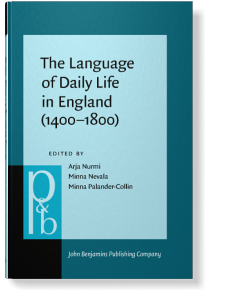The Language of Daily Life in England (1400–1800)
Editors
The Language of Daily Life in England (1400–1800) is an important state-of-the art account of historical sociolinguistic and socio-pragmatic research. The volume contains nine studies and an introductory essay which discuss linguistic and social variation and change over four centuries. Each study tackles a linguistic or social phenomenon, and approaches it with a combination of quantitative and qualitative methods, always embedded in the socio-historical context. The volume presents new information on linguistic variation and change, while evaluating and developing the relevant theoretical and methodological tools. The writers form one of the leading research teams in the field, and, as compilers of the Corpus of Early English Correspondence, have an informed understanding of the data in all its depth. This volume will be of interest to scholars in historical linguistics, sociolinguistics and socio-pragmatics, but also e.g. social history. The approachable style of writing makes it also inviting for advanced students.
[Pragmatics & Beyond New Series, 183] 2009. vii, 312 pp.
Publishing status: Available
© John Benjamins Publishing Company
Table of Contents
-
Acknowledgements | p. vii
-
The language of daily life in the history of English: Studying how macro meets microMinna Palander-Collin, Minna Nevala and Arja Nurmi | pp. 1–23
-
Section 1. Variation and social relations
-
Negotiating interpersonal identities in writing: Code-switching practices in Charles Burney's correspondencePäivi Pahta and Arja Nurmi | pp. 27–52
-
Patterns of interaction: Self-mention and addressee inclusion in letters of Nathaniel Bacon and his correspondentsMinna Palander-Collin | pp. 53–74
-
Referential terms and expressions in eighteenth-century letters: A case study on the Lunar men of BirminghamMinna Nevala | pp. 75–103
-
Section 2. Methodological considerations in the study of change
-
Methodological and practical aspects of historical network analysis: A case study of the Bluestocking lettersAnni Sairio | pp. 107–135
-
Grasshoppers and blind beetles: Caregiver language in Early Modern English correspondenceTerttu Nevalainen | pp. 137–164
-
Lifespan changes in the language of three early modern gentlemenHelena Raumolin-Brunberg | pp. 165–196
-
Section 3. Sociohistorical context
-
Singular YOU WAS/WERE variation and English normative grammars in the eighteenth centuryMikko Laitinen | pp. 199–217
-
Encountering and appropriating the Other: East India Company merchants and foreign terminologySamuli Kaislaniemi | pp. 219–251
-
Everyday possessions: Family and identity in the correspondence of John Paston IITeo Juvonen | pp. 253–277
-
Appendix: Editions in the Corpora of Early English Correspondence | pp. 279–302
-
Name index | pp. 303–307
-
Subject index | pp. 309–312
“As much of the work presented in this book is ongoing, the overall value lies largely in the detailed discussions and evaluations of methods and approaches, making it very useful for anyone teaching historical sociolinguistics - and as the Historical Sociolinguistics Network [...] shows, this is a growing field. In particular, Raumolin-Brunberg's study must be singled out as condensing a tremendous amount of material as she contrasts the language of individual speakers with that of their generation. The CEEC project has been running since 1993 and its output over the years has greatly refined our knowledge of the history of English; this volume shows that there is still much to be learnt.”
Laura Wright, University of Cambridge, in the Journal of Historical Pragmatics, Vol. 11:2 (2010)
“
The Language of Daily Life in England (1400-1800) is an important state-of-theart account of historical sociolinguistic and socio-pragmatic research. It presents new information on linguistic variation and change while evaluating and developing the relevant theoretical and methodological tools. The selection and order of contributions results in a coherent and comprehensive volume of cutting-edge research. The range of methodologies employed and spectrum of linguistic features investigated make this volume a valuable resource for scholars in historical linguistics, sociolinguistics, socio-pragmatics and social history. The results of research presented in the book are an excellent way of showing that in sociolinguistics today cross-disciplinary, multi-layered approaches are increasingly called for as a way of reaching beyond traditional paradigms and established categories.”
Lelija Socanac, University of Zagreb, Croatia, on Linguist List 21.2240 (2011)
Cited by (13)
Cited by 13 other publications
Marcus, Imogen & Mel Evans
2019. “Right trusty and well-beloved”. In Reference and Identity in Public Discourses [Pragmatics & Beyond New Series, 306], ► pp. 67 ff. 
Evans, Mel
2017. Rutten, Gijsbert and Marijke J. van der Wal. 2014. Letters as Loot: A Sociolinguistic Approach to Seventeenth- and Eighteenth-Century Dutch
. Journal of Historical Pragmatics 18:1 ► pp. 136 ff. 
Włodarczyk, Matylda
2017. Auer, Anita, Daniel Schreier and Richard Watts (eds). 2015.Letter Writing and Language Change. Journal of Historical Pragmatics 18:1 ► pp. 142 ff. 
Conde-Silvestre, J. Camilo
Conde-Silvestre, J. Camilo
2022. Historical sociolinguistics. In Handbook of Pragmatics [Handbook of Pragmatics, ], ► pp. 756 ff. 
Nevala, Minna
2015. Review of Dossena & Lungo Camiciotti (2012): Letter Writing in Late Modern Europe. Journal of Historical Pragmatics 16:1 ► pp. 148 ff. 
Nevala, Minna
NEVALAINEN, TERTTU
Kiełkiewicz‐Janowiak, Agnieszka
Nevalainen, Terttu & Helena Raumolin‐Brunberg
Nevalainen, Terttu, Helena Raumolin-Brunberg & Heikki Mannila
[no author supplied]
[no author supplied]
This list is based on CrossRef data as of 20 september 2024. Please note that it may not be complete. Sources presented here have been supplied by the respective publishers. Any errors therein should be reported to them.
Subjects
Main BIC Subject
CFB: Sociolinguistics
Main BISAC Subject
LAN009000: LANGUAGE ARTS & DISCIPLINES / Linguistics / General
